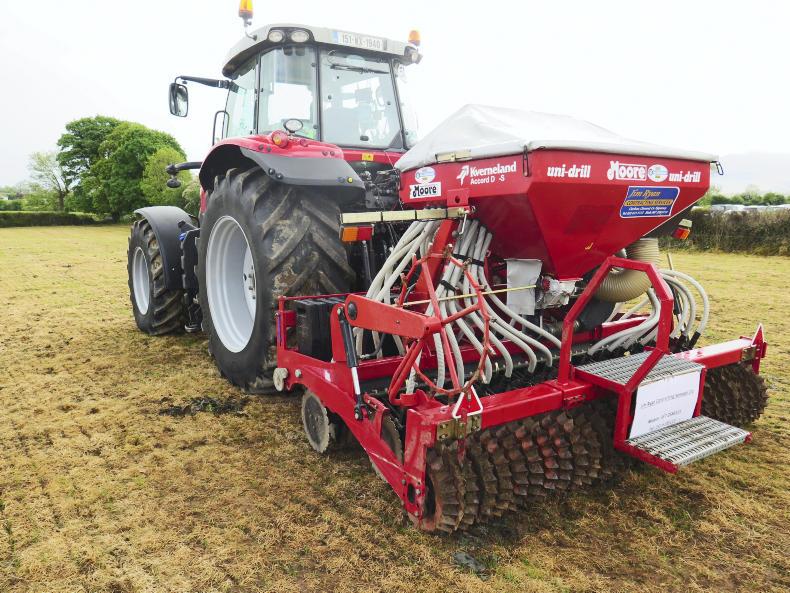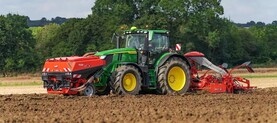Those selling grass seed are saying that sales are well up on last year, even at this early stage. Dry weather in April and early May, combined with higher prices for milk and beef, has led to a renewed interest in pasture renewal.
This was reflected in big crowds attending reseeding events in Westmeath and Tipperary recently. At the Irish Grassland Association event on Donald and Lucy Bateman’s farm in Ballylooby, Co Tipperary, three types of reseeding methods were presented.
Donald and Lucy are milking 230 cows on a combination of owned and rented land. In 2016, the herd EBI was €107, the herd was stocked at 2.85 cows/ha and they produced 440kgMS/cow or 1,254kgMS/ha from 550kg of meal fed. The farm grew an average of 14.5t/ha of grass across all hectares. All replacements are contract-reared.
Donald reseeded 20 acres on 18 April. This area was chosen for reseeding as it was consistently growing 2 to 3t/ha of grass less than the farm average. Donald knew this because he measures grass growth in all paddocks every week.
The majority of the reseeding was completed with a one-pass (power harrow and seed drill combination) but two other methods were trialled, for the purpose of the reseeding event.
The other methods used were the Einboch, which is a light tine and air seed drill combination and the Moore Unidrill, which sows seeds in slots. All three methods were used on the same day, one month prior to the public event which was held last Wednesday.
Unusually, there was no rain for three weeks after sowing and the first two weeks after sowing were quite harsh, with strong easterly winds – so far from ideal conditions for grass seed germination. It was only in the past 10 days or so that the seeds have begun to emerge, so they were well behind on where you would expect them to be four weeks after sowing.
Procedure
On 25 March, the field was grazed by the Bateman herd as part of the first round of grazing. The field was sprayed off with round-up on 3 April and grazed by the herd on 10 April. While there was only a week between grazing and spraying, Donald reckoned there was a better chance of killing more of the weed grasses after the field was grazed, as opposed to before grazing when a lot of the weeds and grasses would have been shaded by the taller perennial ryegrass.
Two tonne/acre of lime was spread on 15 April and the machines rolled in on 18 April. Donald’s flat roller gave up on him after he started rolling so he had to borrow a ring roller to finish the job. Two days after sowing Donald spread two bags/acre of 0:7:30 on the field.
The first question asked at the event was why Donald didn’t plough the field. His response was that firstly, the fields didn’t need ploughing with no obvious humps or hollows that needed correcting.
Secondly, he doesn’t like the work of picking stones after ploughing and finally, he has used minimum cultivation techniques before and likes them. He said he is also concerned about the risk of ploughing down nutrients when ploughing.
Results
As the pictures demonstrate, neither method looked particularly good on the day of the walk. One month after sowing, you would expect the seedlings to be much stronger and you would expect to be getting the first grazing in another month. But looking at the seedlings on the day, some farmers were wondering if any had even germinated on one treatment, let alone talk about grazing them.
There is no doubt that the seeds sown with the one-pass and the Moore Unidrill were at a much more advanced stage than the seeds sown by the Einboch. From a distance, you would think there were no seeds up that were sown by the Einboch, but when you go down on your hands and knees, you can actually see that the seeds have germinated.
John Maher from Teagasc went through the different methods on the day. He said that at this stage a well-established reseed should see a seedling within 4in of another seedling. He said that over time more seeds will germinate and the germinated plants will tiller out. John said that all three methods had seedlings within 4in of each other, but that the Einboch seedlings had germinated later so were smaller than the seedlings in the other plots.
There were also differences between the one-pass and Moore Unidrill plots. The seeds sown by the Moore Unidrill emerged in lines, as the drill sows the seed in a slot. While there was similar number of seeds germinated, the fact that they are sown in lines probably means that they will have to work harder to tiller out. The seedlings from the one-pass method are probably more spread out.
However, it must be said that in most cases looking at seedlings at different stages of growth now is largely academic because in three or four months’ time there will probably be no difference between any of the plots. That said, if one method slows down the turnaround time between sowing and getting the first grazing it should be recognised as a disadvantage.
Issues
Stan Lalor from Grassland Agro spoke about soil fertility when reseeding. Stan says that a new reseed has to work twice as hard as established grass as it needs to grow two ways: Grow leaves up and roots down, so soil fertility is extra important.
He says that soils at index three should get 30kg/ha of phosphorus and 50kg/ha of potassium at sowing along with 30 kg/ha of nitrogen and a further 30kg/ha of nitrogen after emergence. He says the forgotten nutrient when reseeding is sulphur, of which 5kg/ha should be spread in the first six weeks after sowing.
Chris Maughan from Whelehan Crop Protection spoke about weed control when reseeding. He said the first thing to do is to burn off the existing vegetation. He said most farmers will spray with glyphosate (eg Roundup) and wait five days before grazing or cutting. He said that cutting the sprayed grass for silage is becoming more popular, but you must be prepared to cut it when it is at the right stage, and sometimes the weather can be a problem.
He said that the longer the sprayed field is left before cultivating the better. He suggests at least two weeks, but by right established docks will need up to five weeks for the spray to penetrate all the root. However, he said that this is usually not practical. Post-emergence, he said docks are the biggest problem. A post-emergence dock spray must be used on all reseeds. Timing is critical. The best time to kill the docks is at the seedling stage. John said it can be hard to identify seedling docks as they look nothing like an established dock.
Seedling docks have two leaves. The best time to spray is when each dock leaf is about the size of a €2 coin. In many cases, new reseeds have seedling docks but also re-established docks from root shards that didn’t get killed by the glyphosate. Both seedling docks and docks from root shards were present on the Bateman reseeds. Chris said that from the grass point of view, the best time to spray is when the third leaf of the grass seedling is out. While many of the grass seedlings on the one-pass side of the field were at three leaves, it was felt that that the grass was under too much stress to spray right now.
First grazing
On first grazing, Donald says that his preference is to graze the reseeds with the milking cows when they are at a cover of about 700kg/ha, which is a really light grazing.
Asked why he doesn’t wait longer, he said that the sooner they are grazed the more they will tiller. Asked why he doesn’t graze with lighter stock he said that calves would spend a few weeks grazing the reseeds and he would have missed the chance to graze them at the right cover so he prefers to go in and out with the milkers.
Meanwhile and on the same subject of land improvement, speaking at an Arrabawn farm walk on Charlie Whiriskey’s farm in Athenry, Co Galway, last Friday, James O’Loughlin from Teagasc said that farmers should focus on improving the performance of their good land before investing in drainage works on marginal land.
“One of the main outcomes from the Heavy Soils Programme is that soil fertility is a major issue on farms with heavy soils and in high-rainfall areas. Even the drier parts of heavy farms were exceptionally low in pH and had low soil P and K levels and it is a major challenge to get them up to target levels. But the key to improving the overall performance of these heavy farms is to get the good parts of the farm up to target and then focus on improving the wetter parts as stock numbers increase and the demand for grass increases too,” James said.






 This is a subscriber-only article
This is a subscriber-only article















SHARING OPTIONS: